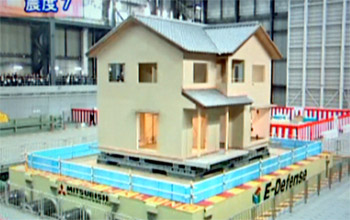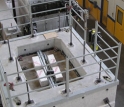|

Press Release 05-158
Japan and U.S. National Science Foundation to Collaborate on Disaster Prevention Research

New agreement on earthquake simulators adds to ocean research
September 12, 2005
As part of a full week of activities in Japan, U.S. National Science Foundation (NSF) Director Arden L. Bement, Jr., and Japanese deputy education, science and technology minister Tetsuhisa Shirakawa signed an agreement on Sept. 11 to enhance both countries' efforts to work together to combat the devastation of natural disasters.
The formal agreement, known as the "Memorandum Concerning Cooperation in the Area of Disaster Prevention Research," was signed in Kyoto to enable Japanese and American researchers to share access to new experimental facilities, namely, the George E. Brown, Jr., Network for Earthquake Engineering Simulation (NEES)--a group of 15 U.S. experimental facilities linked through advanced communication networks--and the world's largest shake table, the 3-D Full-Scale Earthquake Testing Facility, known as E-Defense (Earth-Defense), located in Miki City, Japan.
The memo endorses collaborative research, sharing of research activities through E-Defense and NEES cyberinfrastructure and the exchange of research results. The programs will also exchange scientists and engineers, including early career researchers and students.
The Japanese earthquake-testing facility came on line in January 2005 on the 10th anniversary of the Kobe earthquake. E-Defense allows the testing of structures subjected to simulated high-intensity earthquakes. The massive shake table platform measures 65 feet by 50 feet (20 meters by 15 meters) and will accommodate a four-story building weighing 1,200 tons. Bement tours E-Defense, which is funded by Japan's Ministry of Education, Culture, Sports, Science and Technology (MEXT), on Sept. 13.
On Sept. 10, in an event hosted by the Japan Agency for Marine-Earth Science and Technology, Bement celebrated delivery of the deep ocean-drilling vessel Chikyu--the Japanese word for Earth--which will be used in the Integrated Ocean Drilling Program (IODP). Chiku can drill deeper into the Earth than any other scientific drilling ship.
IODP is a long-term international effort to unravel the mysteries of the Earth's structure and history through analyses of marine sediments and rocks. Launched in October 2003, IODP is the product of collaboration among the United States, Japan and the European Union. NSF and MEXT serve as co-leaders of IODP.
During his visit, the NSF director will also participate in two symposiums, including plenary remarks at a forum on "Science and Technology in Society," which provides a mechanism for open, informal discussions among senior science and technology leaders. Attendees will have an opportunity to discuss how to best implement research advances while addressing new ethical, safety and environmental concerns.
Bement will speak on "Imagining an Innovative Future" at the U.S.-Japan Innovation Summit, sponsored by the U.S. Council on Competitiveness and Innovation in Nagoya. The summit fosters dialogue among private and public sector leaders from both nations to encourage collaboration.
-NSF-

Media Contacts
Leslie Fink, NSF (703) 292-5395 lfink@nsf.gov
Program Contacts
Anne Emig, OISE (703) 292-7241 aemig@nsf.gov

The National Science Foundation (NSF) is an independent federal agency that supports fundamental research and education across all fields of science and engineering. In fiscal year (FY) 2009, its budget is $9.5 billion, which includes $3.0 billion provided through the American Recovery and Reinvestment Act. NSF funds reach all 50 states through grants to over 1,900 universities and institutions. Each year, NSF receives about 44,400 competitive requests for funding, and makes over 11,500 new funding awards. NSF also awards over $400 million in professional and service contracts yearly.
 Get News Updates by Email Get News Updates by Email
Useful NSF Web Sites:
NSF Home Page: http://www.nsf.gov
NSF News: http://www.nsf.gov/news/
For the News Media: http://www.nsf.gov/news/newsroom.jsp
Science and Engineering Statistics: http://www.nsf.gov/statistics/
Awards Searches: http://www.nsf.gov/awardsearch/
| 


